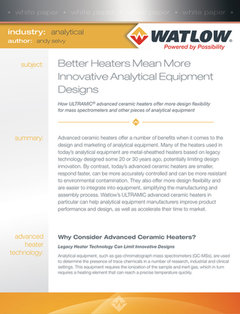How ULTRAMIC heaters support innovative analytical equipment designs
Advanced ceramic heaters offer numerous benefits in the design of analytical equipment. Many of the heaters used in industry today are metal sheathed, a long-standing technology that has been available for over 30 years. While such heaters are excellent for a wide variety of complex thermal applications, today’s newer and more advanced analytical equipment requires higher performance and precision. Here, Andy Selvy Chief System Designer at industrial technology company Watlow, explores the benefits of advanced ceramic heaters.
Discover More
Download Whitepaper
Analytical equipment, such as gas-chromatograph mass spectrometers (GC-MS), is used to determine the presence of trace chemicals, alcohols and hormones and separate complex mixtures in a number of research, industrial and clinical applications. For example, GC-MS detect concentrations of drugs in blood, as well as contaminants in air, water and soil, and can help to develop new pharmaceutical products.
The MS component breaks each separated compound coming from the GC into ionized fragments, which requires a high energy beam of electrons to pass through the sample molecule to produce electrically charged particles or ions.
The equipment requires the ionization of the sample and inert gas, and so a heating element that can reach a precise temperature quickly is a vital component. However, many legacy heating technologies that have exerted their performance and reliability and now must be designed to reflect the smaller, higher throughput analytical equipment that is taking over the market. This means heaters must also be smaller to enable miniaturization and optimize performance.
Today’s heaters
Modern advanced ceramic heaters can achieve higher performance and precision criteria, while allowing for greater design flexibility and faster time to market.
To appreciate the recent innovation in heating technology, it helps to understand some of the limitations faced by more traditional metal heaters. These heaters must be inserted into another block of metal inside the equipment in order to perform their thermal job. As the heater sheath and the block are made of metal, they cannot meet the ion source and often require additional electrical isolation.
These design tradeoffs require a larger carbon footprint, as well as a more complex assembly procedure. Metal-sheathed heaters also typically require longer heat-up and cool-down times, given that there is more mass in the heater and holder. This results in slower system startup and changes between set points.
Advances in ceramic heater technology overcome many of these issues and offer greater design flexibility and performance. Advanced ceramic heaters allow equipment designers to create room for new components, reduce a machine’s overall footprint, improve accuracy and performance, all while simplifying the manufacturing and assembly process, reducing the effectiveness of the analytical equipment.
The benefits of advanced ceramic heaters
To allow for more innovative designs, Watlow has developed ULTRAMIC, an advanced, high-performance ceramic heater. ULTRAMIC advanced ceramic heaters are designed for optimal performance in thermal applications where rapid thermal cycling and more precise control is needed.
ULTRAMIC heaters are constructed from aluminum nitride (AIN) and incorporate a thermally matched, proprietary heating element. AlN is especially suitable for applications requiring a clean, non-contaminating heat source. Additionally, excellent geometric stability ensures consistent part-to-part thermal contact during heating cycles.
These components, used together in the right circumstances, give rise to a number of unique properties including high electrical isolation, with low-leakage current, superior chemical resistance, high thermal conductivity and temperature uniformity across the heater surface, plus high durability.
Today’s analytical equipment has surpassed the innovation of heaters designed 30 years ago. To ensure design innovation is not limited, equipment designers must consider more advanced heaters in their equipment.
Advanced ceramic heaters are smaller, respond faster and can be more resistant to environmental contamination compared to conventional heaters. In particular, Watlow’s ULTRAMIC advanced ceramic heaters can help analytical equipment manufacturers improve product performance and design, as well as accelerate their time to market.
ABOUT Watlow
Founded in 1922, Watlow strives to be the leading provider of innovative thermal solutions for the world’s most demanding applications. Our advanced technologies are ideally suited for vital applications such as front-end semiconductor processing, clean and environmentally-friendly energy systems and processes and lifesaving medical and clinical equipment, to name a few. Since 1922, Watlow has grown in product capability, market experience and global reach. The company holds more than 980 patents and employs 3,000 team members working in nine manufacturing facilities and three technology centers in the United States, Mexico, Europe and Asia. Watlow also has sales offices in 50 countries around the world. The company continues to grow, while the commitment remains the same – to provide its customers with superior products and services for their individual needs.
For more information about Watlow’s products, go to www.watlow.com.
If you want to ensure you keep up to date with the latest content from Watlow, visit the website: www.watlow.com/news
For further information contact:
European headquarters:
Johann Lainer
Tel: +43 6244 201 29-0
E-mail: watlowleads@watlowleads.com

